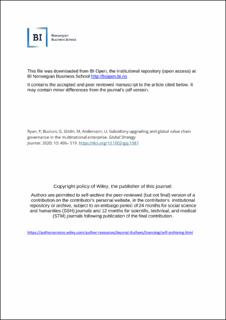Subsidiary upgrading and global value chain governance in the multinational enterprise
| dc.contributor.author | Ryan, Paul | |
| dc.contributor.author | Buciuni, Giulio | |
| dc.contributor.author | Giblin, Majella | |
| dc.contributor.author | Andersson, Ulf | |
| dc.date.accessioned | 2023-04-25T12:05:58Z | |
| dc.date.available | 2023-04-25T12:05:58Z | |
| dc.date.created | 2020-09-02T14:59:40Z | |
| dc.date.issued | 2020 | |
| dc.identifier.citation | Global Strategy Journal. 2020, 10 (3), 496-519. | en_US |
| dc.identifier.issn | 2042-5791 | |
| dc.identifier.uri | https://hdl.handle.net/11250/3064948 | |
| dc.description.abstract | Upgrading and governance in global value chains (GVCs) have been understood mainly through studying the buyer–supplier transaction, where the supplier is typically an independent contractor from a developing economy. Little is known about how subsidiaries of multinational enterprises (MNEs) can upgrade in a GVC, whose core activities are coordinated through the “hierarchy” governance model. Using an in‐depth longitudinal single case study in the medical devices industry, we explain how a subsidiary can accomplish upgrading in an intra‐MNE GVC and, over time, increase its control of this GVC reaching a joint coordinator role for its governance. Our findings show that partaking in innovation may not be the final stage of a subsidiary's upgrading but can represent the start of a new phase that culminates with joint coordination of the GVC. | en_US |
| dc.language.iso | eng | en_US |
| dc.publisher | Wiley | en_US |
| dc.title | Subsidiary upgrading and global value chain governance in the multinational enterprise | en_US |
| dc.type | Journal article | en_US |
| dc.type | Peer reviewed | en_US |
| dc.description.version | submittedVersion | en_US |
| dc.source.pagenumber | 496-519 | en_US |
| dc.source.volume | 10 | en_US |
| dc.source.journal | Global Strategy Journal | en_US |
| dc.source.issue | 3 | en_US |
| dc.identifier.doi | 10.1002/gsj.1387 | |
| dc.identifier.cristin | 1826828 | |
| cristin.ispublished | true | |
| cristin.fulltext | preprint | |
| cristin.qualitycode | 1 |
